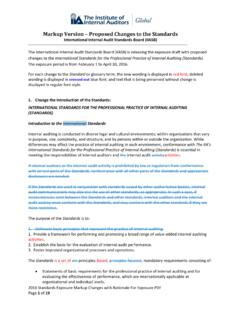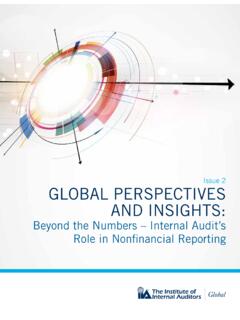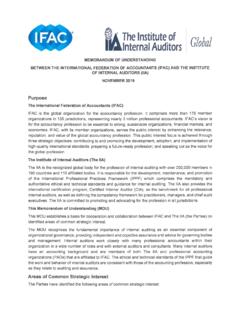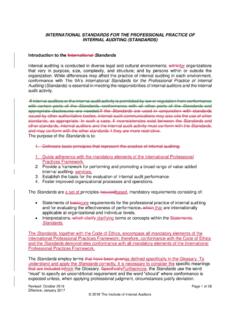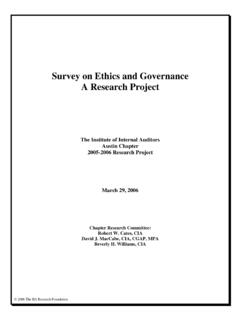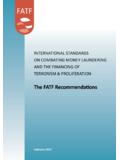Transcription of MODEL INTERNAL AUDIT ACTIVITY CHARTER
1 Revised: 05/2013 The Institute of INTERNAL Auditors Page 1 of 4 MODEL INTERNAL AUDIT ACTIVITY CHARTER INTRODUCTION: INTERNAL Auditing is an independent and objective assurance and consulting ACTIVITY that is guided by a philosophy of adding value to improve the operations of the <organization>. It assists <organization> in accomplishing its objectives by bringing a systematic and disciplined approach to evaluate and improve the effectiveness of the organization's governance, risk management, INTERNAL control. ROLE: The INTERNAL AUDIT ACTIVITY is established by the Board of Directors, AUDIT Committee, or highest level of governing body (hereafter referred to as the Board).
2 The INTERNAL AUDIT ACTIVITY s responsibilities are defined by the Board as part of their oversight role. PROFESSIONALISM: The INTERNAL AUDIT ACTIVITY will govern itself by adherence to The Institute of INTERNAL Auditors' mandatory guidance including the Definition of INTERNAL Auditing, the Code of Ethics, and the International Standards for the Professional Practice of INTERNAL Auditing (Standards). This mandatory guidance constitutes principles of the fundamental requirements for the professional practice of INTERNAL auditing and for evaluating the effectiveness of the INTERNAL AUDIT ACTIVITY s performance. The Institute of INTERNAL Auditors' Practice Advisories, Practice Guides, and Position Papers will also be adhered to as applicable to guide operations.
3 In addition, the INTERNAL AUDIT ACTIVITY will adhere to <organization> relevant policies and procedures and the INTERNAL AUDIT ACTIVITY 's standard operating procedures manual. AUTHORITY: The INTERNAL AUDIT ACTIVITY , with strict accountability for confidentiality and safeguarding records and information, is authorized full, free, and unrestricted access to any and all of <organization> records, physical properties, and personnel pertinent to carrying out any engagement. All employees are requested to assist the INTERNAL AUDIT ACTIVITY in fulfilling its roles and responsibilities. The INTERNAL AUDIT ACTIVITY will also have free and unrestricted access to the Board. ORGANIZATION: The Chief AUDIT Executive will report functionally to the Board and administratively ( day to day operations) to the Chief Executive Officer.
4 The Board will Approve the INTERNAL AUDIT CHARTER . Approve the risk based INTERNAL AUDIT plan. Approve the INTERNAL AUDIT budget and resource plan. Receive communications from the Chief AUDIT Executive on the INTERNAL AUDIT ACTIVITY s performance relative to its plan and other matters. Revised: 05/2013 The Institute of INTERNAL Auditors Page 2 of 4 MODEL INTERNAL AUDIT ACTIVITY CHARTER Approve decisions regarding the appointment and removal of the Chief AUDIT Executive. Approve the remuneration of the Chief AUDIT Executive. Make appropriate inquiries of management and the Chief AUDIT Executive to determine whether there is inappropriate scope or resource limitations. The Chief AUDIT Executive will communicate and interact directly with the Board, including in executive sessions and between Board meetings as appropriate.
5 INDEPENDENCE AND OBJECTIVITY: The INTERNAL AUDIT ACTIVITY will remain free from interference by any element in the organization, including matters of AUDIT selection, scope, procedures, frequency, timing, or report content to permit maintenance of a necessary independent and objective mental attitude. INTERNAL auditors will have no direct operational responsibility or authority over any of the activities audited. Accordingly, they will not implement INTERNAL controls, develop procedures, install systems, prepare records, or engage in any other ACTIVITY that may impair INTERNAL auditor s judgment. INTERNAL auditors will exhibit the highest level of professional objectivity in gathering, evaluating, and communicating information about the ACTIVITY or process being examined.
6 INTERNAL auditors will make a balanced assessment of all the relevant circumstances and not be unduly influenced by their own interests or by others in forming judgments. The Chief AUDIT Executive will confirm to the board, at least annually, the organizational independence of the INTERNAL AUDIT ACTIVITY . RESPONSIBILITY: The scope of INTERNAL auditing encompasses, but is not limited to, the examination and evaluation of the adequacy and effectiveness of the organization's governance, risk management, and INTERNAL controls as well as the quality of performance in carrying out assigned responsibilities to achieve the organization s stated goals and objectives.
7 This includes: Evaluating risk exposure relating to achievement of the organization s strategic objectives. Evaluating the reliability and integrity of information and the means used to identify, measure, classify, and report such information. Evaluating the systems established to ensure compliance with those policies, plans, procedures, laws, and regulations which could have a significant impact on the organization. Evaluating the means of safeguarding assets and, as appropriate, verifying the existence of such assets. Evaluating the effectiveness and efficiency with which resources are employed. Revised: 05/2013 The Institute of INTERNAL Auditors Page 3 of 4 MODEL INTERNAL AUDIT ACTIVITY CHARTER Evaluating operations or programs to ascertain whether results are consistent with established objectives and goals and whether the operations or programs are being carried out as planned.
8 Monitoring and evaluating governance processes. Monitoring and evaluating the effectiveness of the organization's risk management processes. Evaluating the quality of performance of external auditors and the degree of coordination with INTERNAL AUDIT . Performing consulting and advisory services related to governance, risk management and control as appropriate for the organization. Reporting periodically on the INTERNAL AUDIT ACTIVITY s purpose, authority, responsibility, and performance relative to its plan. Reporting significant risk exposures and control issues, including fraud risks, governance issues, and other matters needed or requested by the Board.
9 Evaluating specific operations at the request of the Board or management, as appropriate. INTERNAL AUDIT PLAN: At least annually, the Chief AUDIT Executive will submit to senior management and the Board an INTERNAL AUDIT plan for review and approval. The INTERNAL AUDIT plan will consist of a work schedule as well as budget and resource requirements for the next fiscal/calendar year. The Chief AUDIT Executive will communicate the impact of resource limitations and significant interim changes to senior management and the Board. The INTERNAL AUDIT plan will be developed based on a prioritization of the AUDIT universe using a risk-based methodology, including input of senior management and the Board.
10 The Chief AUDIT Executive will review and adjust the plan, as necessary, in response to changes in the organization s business, risks, operations, programs, systems, and controls. Any significant deviation from the approved INTERNAL AUDIT plan will be communicated to senior management and the Board through periodic ACTIVITY reports. REPORTING AND MONITORING: A written report will be prepared and issued by the Chief AUDIT Executive or designee following the conclusion of each INTERNAL AUDIT engagement and will be distributed as appropriate. INTERNAL AUDIT results will also be communicated to the Board. The INTERNAL AUDIT report may include management s response and corrective action taken or to be taken in regard to the specific findings and recommendations.
